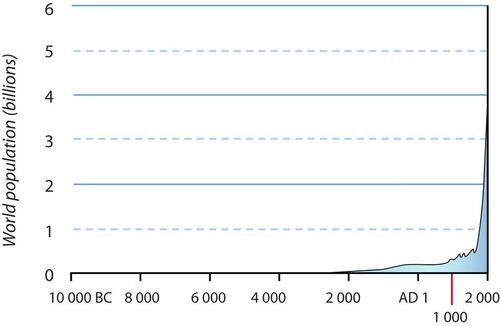6.13: Población Humana
- Page ID
- 107973
\( \newcommand{\vecs}[1]{\overset { \scriptstyle \rightharpoonup} {\mathbf{#1}} } \)
\( \newcommand{\vecd}[1]{\overset{-\!-\!\rightharpoonup}{\vphantom{a}\smash {#1}}} \)
\( \newcommand{\dsum}{\displaystyle\sum\limits} \)
\( \newcommand{\dint}{\displaystyle\int\limits} \)
\( \newcommand{\dlim}{\displaystyle\lim\limits} \)
\( \newcommand{\id}{\mathrm{id}}\) \( \newcommand{\Span}{\mathrm{span}}\)
( \newcommand{\kernel}{\mathrm{null}\,}\) \( \newcommand{\range}{\mathrm{range}\,}\)
\( \newcommand{\RealPart}{\mathrm{Re}}\) \( \newcommand{\ImaginaryPart}{\mathrm{Im}}\)
\( \newcommand{\Argument}{\mathrm{Arg}}\) \( \newcommand{\norm}[1]{\| #1 \|}\)
\( \newcommand{\inner}[2]{\langle #1, #2 \rangle}\)
\( \newcommand{\Span}{\mathrm{span}}\)
\( \newcommand{\id}{\mathrm{id}}\)
\( \newcommand{\Span}{\mathrm{span}}\)
\( \newcommand{\kernel}{\mathrm{null}\,}\)
\( \newcommand{\range}{\mathrm{range}\,}\)
\( \newcommand{\RealPart}{\mathrm{Re}}\)
\( \newcommand{\ImaginaryPart}{\mathrm{Im}}\)
\( \newcommand{\Argument}{\mathrm{Arg}}\)
\( \newcommand{\norm}[1]{\| #1 \|}\)
\( \newcommand{\inner}[2]{\langle #1, #2 \rangle}\)
\( \newcommand{\Span}{\mathrm{span}}\) \( \newcommand{\AA}{\unicode[.8,0]{x212B}}\)
\( \newcommand{\vectorA}[1]{\vec{#1}} % arrow\)
\( \newcommand{\vectorAt}[1]{\vec{\text{#1}}} % arrow\)
\( \newcommand{\vectorB}[1]{\overset { \scriptstyle \rightharpoonup} {\mathbf{#1}} } \)
\( \newcommand{\vectorC}[1]{\textbf{#1}} \)
\( \newcommand{\vectorD}[1]{\overrightarrow{#1}} \)
\( \newcommand{\vectorDt}[1]{\overrightarrow{\text{#1}}} \)
\( \newcommand{\vectE}[1]{\overset{-\!-\!\rightharpoonup}{\vphantom{a}\smash{\mathbf {#1}}}} \)
\( \newcommand{\vecs}[1]{\overset { \scriptstyle \rightharpoonup} {\mathbf{#1}} } \)
\( \newcommand{\vecd}[1]{\overset{-\!-\!\rightharpoonup}{\vphantom{a}\smash {#1}}} \)
\(\newcommand{\avec}{\mathbf a}\) \(\newcommand{\bvec}{\mathbf b}\) \(\newcommand{\cvec}{\mathbf c}\) \(\newcommand{\dvec}{\mathbf d}\) \(\newcommand{\dtil}{\widetilde{\mathbf d}}\) \(\newcommand{\evec}{\mathbf e}\) \(\newcommand{\fvec}{\mathbf f}\) \(\newcommand{\nvec}{\mathbf n}\) \(\newcommand{\pvec}{\mathbf p}\) \(\newcommand{\qvec}{\mathbf q}\) \(\newcommand{\svec}{\mathbf s}\) \(\newcommand{\tvec}{\mathbf t}\) \(\newcommand{\uvec}{\mathbf u}\) \(\newcommand{\vvec}{\mathbf v}\) \(\newcommand{\wvec}{\mathbf w}\) \(\newcommand{\xvec}{\mathbf x}\) \(\newcommand{\yvec}{\mathbf y}\) \(\newcommand{\zvec}{\mathbf z}\) \(\newcommand{\rvec}{\mathbf r}\) \(\newcommand{\mvec}{\mathbf m}\) \(\newcommand{\zerovec}{\mathbf 0}\) \(\newcommand{\onevec}{\mathbf 1}\) \(\newcommand{\real}{\mathbb R}\) \(\newcommand{\twovec}[2]{\left[\begin{array}{r}#1 \\ #2 \end{array}\right]}\) \(\newcommand{\ctwovec}[2]{\left[\begin{array}{c}#1 \\ #2 \end{array}\right]}\) \(\newcommand{\threevec}[3]{\left[\begin{array}{r}#1 \\ #2 \\ #3 \end{array}\right]}\) \(\newcommand{\cthreevec}[3]{\left[\begin{array}{c}#1 \\ #2 \\ #3 \end{array}\right]}\) \(\newcommand{\fourvec}[4]{\left[\begin{array}{r}#1 \\ #2 \\ #3 \\ #4 \end{array}\right]}\) \(\newcommand{\cfourvec}[4]{\left[\begin{array}{c}#1 \\ #2 \\ #3 \\ #4 \end{array}\right]}\) \(\newcommand{\fivevec}[5]{\left[\begin{array}{r}#1 \\ #2 \\ #3 \\ #4 \\ #5 \\ \end{array}\right]}\) \(\newcommand{\cfivevec}[5]{\left[\begin{array}{c}#1 \\ #2 \\ #3 \\ #4 \\ #5 \\ \end{array}\right]}\) \(\newcommand{\mattwo}[4]{\left[\begin{array}{rr}#1 \amp #2 \\ #3 \amp #4 \\ \end{array}\right]}\) \(\newcommand{\laspan}[1]{\text{Span}\{#1\}}\) \(\newcommand{\bcal}{\cal B}\) \(\newcommand{\ccal}{\cal C}\) \(\newcommand{\scal}{\cal S}\) \(\newcommand{\wcal}{\cal W}\) \(\newcommand{\ecal}{\cal E}\) \(\newcommand{\coords}[2]{\left\{#1\right\}_{#2}}\) \(\newcommand{\gray}[1]{\color{gray}{#1}}\) \(\newcommand{\lgray}[1]{\color{lightgray}{#1}}\) \(\newcommand{\rank}{\operatorname{rank}}\) \(\newcommand{\row}{\text{Row}}\) \(\newcommand{\col}{\text{Col}}\) \(\renewcommand{\row}{\text{Row}}\) \(\newcommand{\nul}{\text{Nul}}\) \(\newcommand{\var}{\text{Var}}\) \(\newcommand{\corr}{\text{corr}}\) \(\newcommand{\len}[1]{\left|#1\right|}\) \(\newcommand{\bbar}{\overline{\bvec}}\) \(\newcommand{\bhat}{\widehat{\bvec}}\) \(\newcommand{\bperp}{\bvec^\perp}\) \(\newcommand{\xhat}{\widehat{\xvec}}\) \(\newcommand{\vhat}{\widehat{\vvec}}\) \(\newcommand{\uhat}{\widehat{\uvec}}\) \(\newcommand{\what}{\widehat{\wvec}}\) \(\newcommand{\Sighat}{\widehat{\Sigma}}\) \(\newcommand{\lt}{<}\) \(\newcommand{\gt}{>}\) \(\newcommand{\amp}{&}\) \(\definecolor{fillinmathshade}{gray}{0.9}\)
¿Cómo se adaptan los humanos a su entorno?
Podría decirse que la población humana no tiene que adaptarse a su entorno, sino que obliga al ambiente a cambiar a nuestro gusto. Podemos vivir prácticamente en cualquier lugar que queramos, comer todo tipo de alimentos y construir todo tipo de viviendas. Debido a todas estas “adaptaciones”, nuestra población ha crecido, después de un inicio lento, considerablemente rápido.
La Población Humana
Los humanos han sido llamados las “especies de malezas” más exitosas que la Tierra haya visto jamás. Al igual que las malas hierbas, las poblaciones humanas crecen rápidamente. También se dispersan rápidamente. Han colonizado hábitats de polo a polo. En general, la población humana ha tenido un patrón de crecimiento exponencial, como se muestra en la Figura a continuación. La población aumentó muy lentamente al principio. A medida que aumentó de tamaño, también lo hizo su tasa de crecimiento.
 Crecimiento de la Población Humana. Esta gráfica ofrece una visión general del crecimiento de la población humana desde el 10,000 a.C. El número de humanos tardó hasta cerca del 1800 d.C., en llegar a mil millones. Solo tardaron un poco más de 100 años para que el número llegara a los 2 mil millones. ¡La población humana pasó recientemente la marca de los 7 mil millones! ¿Por qué crees que la población humana comenzó a crecer tan rápido?
Crecimiento de la Población Humana. Esta gráfica ofrece una visión general del crecimiento de la población humana desde el 10,000 a.C. El número de humanos tardó hasta cerca del 1800 d.C., en llegar a mil millones. Solo tardaron un poco más de 100 años para que el número llegara a los 2 mil millones. ¡La población humana pasó recientemente la marca de los 7 mil millones! ¿Por qué crees que la población humana comenzó a crecer tan rápido? Crecimiento temprano de la población
Homo sapiens surgió hace unos 200 mil años en África. Los primeros humanos vivían en pequeñas poblaciones de cazadores nómadas y recolectores. Primero salieron de África hace unos 40 mil años. Pronto se trasladaron por Europa, Asia y Australia. Hace 10 mil años, habían llegado al continente americano. Durante este largo periodo, las tasas de natalidad y mortalidad fueron bastante altas. En consecuencia, el crecimiento poblacional fue lento.
Los humanos inventaron la agricultura hace unos 10 mil años. Esto proporcionó un suministro de alimentos más grande y confiable. También les permitió establecerse en pueblos y ciudades por primera vez. La tasa de mortalidad aumentó debido a enfermedades asociadas a animales domésticos y condiciones de vida abarrotadas. La tasa de natalidad se incrementó porque había más comida y la vida asentada ofrecía otras ventajas. El efecto combinado fue continuo lento crecimiento poblacional.
Resumen
- Los primeros humanos vivían en pequeñas poblaciones de cazadores nómadas y recolectores. Tanto las tasas de natalidad como de mortalidad fueron bastante altas. En consecuencia, el crecimiento de la población humana fue muy lento.
- La invención de la agricultura incrementó tanto las tasas de natalidad como de mortalidad. La población siguió creciendo lentamente.
Revisar
- Describir las tasas de crecimiento poblacional humano.
- ¿Cómo afectó la invención de la agricultura a las tasas de natalidad y mortalidad humanas? ¿Cómo afectó el crecimiento de la población humana?
| Imagen | Referencia | Atribuciones |
 |
[Figura 1] | Crédito: James Cridland Fuente: https://www.flickr.com/photos/jamescridland/613445810/ Licencia: CC BY 2.0 |
 |
[Figura 2] | Crédito: Hana Zavadska Fuente: Fundación CK-12 Licencia: CC BY-NC 3.0 |

